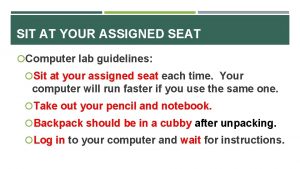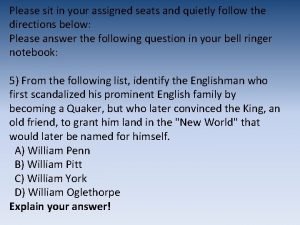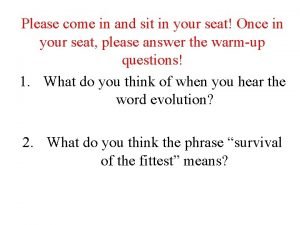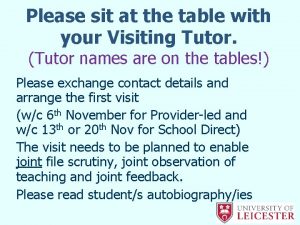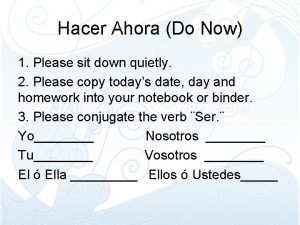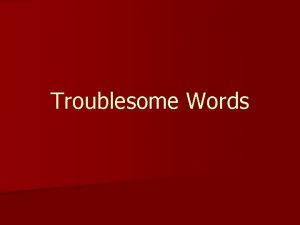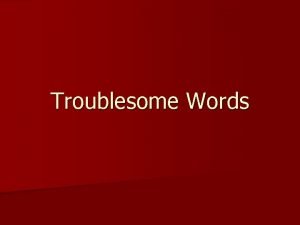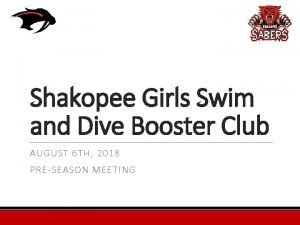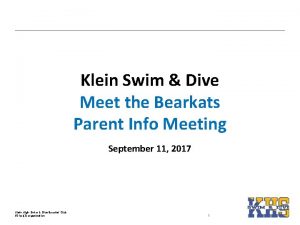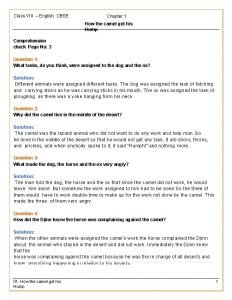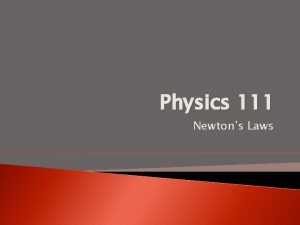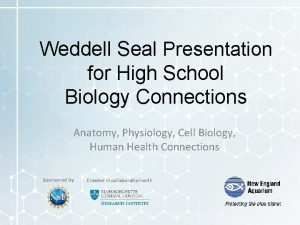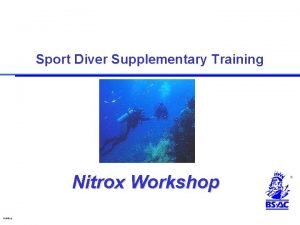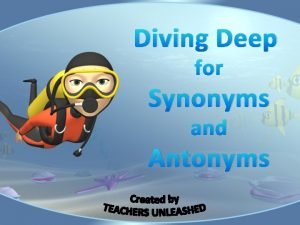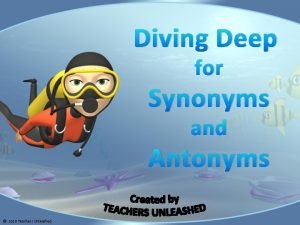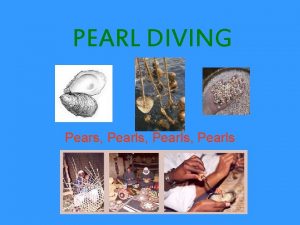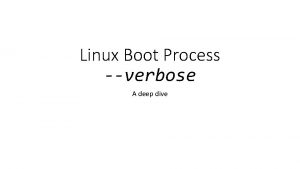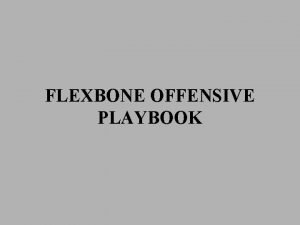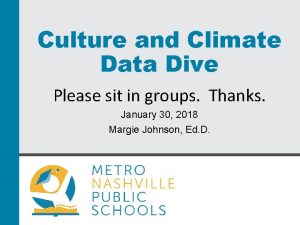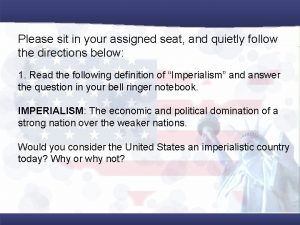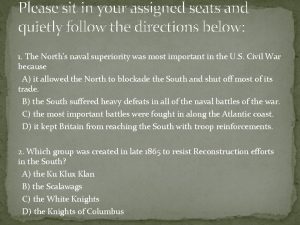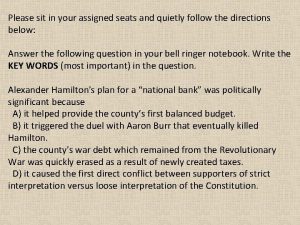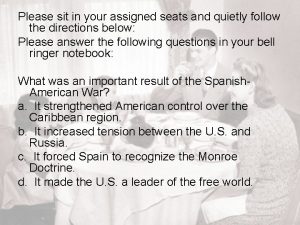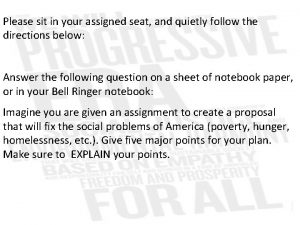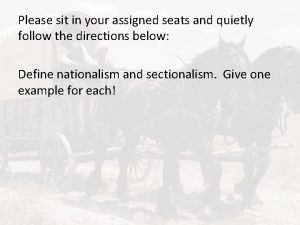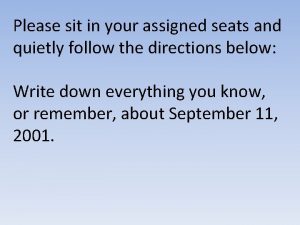Data Dive Please sit in assigned group and































- Slides: 31

Data Dive Please sit in assigned group and introduce yourself. Thanks! November 3, 2017

Welcome NAZA Overview Anna Harutyunyan

Nashville After Zone Alliance PURPOSE To strengthen free, high-quality out-of-school time opportunities that prepare Nashville public school students to succeed in middle school and beyond. Anna Harutyunyan, NAZA Coordinator

The NAZA Afterschool System: Acts as an intermediary between Metro Government and out-ofschool time program (OST) providers Funds program providers on an annual, competitive basis Sets quality standards, monitors programs, evaluates programs’ quality (through the YPQA), and tracks student satisfaction, program quality, and attendance data Provides support to programs on best practices for engaging students in literacy and STEM in the afterschool hours Provides free-of-charge professional development and coaching for youth workers with the aim of supporting the overall quality of programs

NAZA Offers the Following Resources to Funded Program Providers: Access to afternoon and late buses in partnership with MNPS (when possible) Access to afternoon snacks or meals in partnership with MNPS through a federal grant Program spaces in partnership with MNPS and community organizations Professional development opportunities, coaching, resources, materials, and library resources (e. g. Limitless Libraries) New and innovative approaches and models on how to increase motivation and interest in literacy and STEM in partnership with national institutions (Wallace, Rand, Every Hour Counts, Noyce)

NAZA Aims to: Help youth stay engaged in middle school, transition to high school successfully, and graduate from high school Help youth build hard and soft skills Expose youth to post-secondary education and career opportunities Expose youth to enrichment opportunities Strengthen the capacity of youth serving organizations throughout the city to deliver high-quality OST programs

NAZA Students Benefit from: A safe and supportive environment that fosters students’ positive development, helps them academically, and provides them with enrichment opportunities through: Opportunities to develop relationships with caring adults & peers Time for homework help and access to engaging activities (some activities designed to increase their interest in literacy and STEM) Skill building opportunities where they gain skills needed for education, employment and life (e. g. 21 st Century skills) Exposure to different professions and opportunities Voice and choice in activities

Data Tracked by NAZA: Student daily attendance through Sport. Up, that is further bridged to MNPS’ Data Warehouse Student satisfaction through the Youth Asset Survey (YAS) Program staff satisfaction through an annual staff survey Quality of instruction through YPQA observation Student interest and motivation in literacy through the YAS and quality of literacy opportunities offered through the YPQA Quality of STEM programming through the Dimensions of Success tool and students’ engagement in STEM and acquisition of 21 st Century skills through the Common Instrument

What Does the Research Show? According to the American Institutes for Research study of 3 cities in 2014, higher levels of attendance in high-quality NAZA-funded programs was correlated with fewer school-day tardies, fewer disciplinary incidents, and greater improvement in math and science grades According to the 2017 NAZA evaluation conducted by Peabody College: NAZA students showed better growth in school attendance relative to comparison students NAZA students showed better growth on a school discipline outcome relative to comparison students Students who participated in NAZA longer experienced better growth in TCAP scores and school attendance, demonstrated greater decreases in truancy offenses over time, and showed higher PLAN percentile scores

How Did We Do Last Year? Students’ Positive Identity: According to the 2016 -2017 Youth Asset Survey results, 92% of NAZA participants agreed that their NAZA-funded programs’ activities helped them: Learn to be a team player Learn that they could do things that they did not think they could do Feel successful in the activities that they participated in Literacy: 66% of students said they like to read for fun 69% of students said they like to write for fun 89% of students said that adults in their afterschool program encouraged them to read and write in their afterschool program Partnership with Schools: 56% of surveyed managers mentioned they need more connections to schools Overall Instructional Quality: Improved from fall of 2016 to spring of 2017 in 32 out of 42 program sites

2016 -2017 YPQA Pre-and Post-External Assessment Results- NAZA Network Aggregate 5 4. 76 4. 87 4. 40 4. 65 Score 4 3. 48 3. 88 3. 50 2. 96 3 2 1 Safe Environment Supportive Interaction Environment Domain Fall 2016 (N=42) Spring 2017 (N=42) Engagement

2016 -2017 YPQA Literacy Scale Results – NAZA Network Aggregate of External Assessments YPQA Plus Literacy PQA Fall 2016 (n=42) /5 PQA Spring 2017 (n=42) /5 PQA Change 2016 -17 (n=42) Literacy Scale Overall Score 3. 51 4. 13 +0. 63 Literacy 1. Student participation in literacy activities 3. 76 4. 67 +0. 91 Literacy 2. Youth have opportunities to read in multiple contexts 3. 62 4. 24 +0. 62 Literacy 3. Staff encourages youth to write 3. 19 3. 33 +0. 14 2. 76 3. 86 +1. 10 3. 95 4. 38 +0. 43 3. 76 4. 33 +0. 57 Literacy 4. Staff talk with students about vocabulary multiple times Literacy 5. Availability of materials and places for free reading Literacy 6. Youth experience multiple literacy activities

Next to Laura Hansen THANK YOU

Responsible Use of Data Laura Hansen

Lunch and Learn Featuring a panel discussion with: • Cassie Deas, Metro Parks • Jennifer De. Wall, Wright Middle Prep • Patricia Madera, Conexión Americas Introduce yourself at your table.

Collaborative Inquiry Data Dive Margie Johnson, Ed. D.

Outcome Our outcome is to model the collaborative inquiry process for analyzing data and partnering for supporting student success.

Partner Share—Getting Acquainted • Review the Partner Share Form. • Discuss the questions provided on the form.

Data have no meaning. Meaning is imposed through interpretation (Wellman & Lipton, 2004, pp. ix-xi).

How do we bridge the gap between data and results, so all students have educational success? What is the bridge made of? Collaborative Inquiry Data Results Love, 2009

Collaborative Inquiry Cycle Activating and Engaging • What assumptions do we bring? Organizing and Integrating • • • What are some predictions we are making? • What questions are we asking? • What are some possibilities for learning? What inferences, explanations, or conclusions might we draw? What additional data sources might verify our explanations? What solutions might we explore? What data will we need to guide implementation? Managing Modeling Mediating Monitoring Exploring and Discovering • What important points seem to pop out? • What patterns, categories, or trends are emerging? • What seems to be surprising or unexpected? • What are some ways we have not yet explored these data? --Lipton, L. & Wellman, B. (2012

Calibrating Activity— Making Observations

Exploring and Discovering— Data Dive School Dashboard MNPS KPIs NAZA Youth Asset Survey

Collaborative Learning Cycle Activating and Engaging • What assumptions do we bring? Organizing and Integrating Managing Modeling Mediating Exploring and Discovering Monitoring --Lipton, L. & Wellman, B. (2012

Next Steps Commitments One thing that I commit to do for you…. . One thing that you commit to do for me…. . One thing that we commit to do together…… Record on the Next Steps Commitment Sheets along with proposed deadline.

Reflection, Feedback, and Wrap -Up

Exit Ticket Reflection Given what we have discussed and learned today, what might be some actions you take?

Feedback--How Was Today’s Meeting Individually • Use a post-it note to provide feedback.

Wrap Up

MNPS Collaborative Inquiry Toolkit www. mnpscollaboration. org

References Lipton, L. & Wellman, B. (2012). Got data? Now what? Bloomington, IN: Solution Tree. Lipton, L. & Wellman, B. (2011). Groups at work: Strategies and structures for professional learning. Sherman, CT: Mira. Via, LLC. Love, N. (2009). Using data to improve learning for all: A collaborative inquiry approach. Thousand Oaks, CA: Corwin.
 Sit in your assigned seat
Sit in your assigned seat Sit in your assigned seat
Sit in your assigned seat Sit in your assigned seat
Sit in your assigned seat Sit in your assigned seat
Sit in your assigned seat Sit ins
Sit ins Please come in and sit
Please come in and sit Please sit down and your seat belts
Please sit down and your seat belts Paint must never hope to reproduce the faint
Paint must never hope to reproduce the faint Hey hey people
Hey hey people Please sit back and relax
Please sit back and relax Please sit at the table
Please sit at the table Will you please sit at the table
Will you please sit at the table Please sit down
Please sit down Raymond carver will you please be quiet please
Raymond carver will you please be quiet please Identify this group of words. sit!
Identify this group of words. sit! Identify this group of words. sit!
Identify this group of words. sit! Forsyth central swim and dive
Forsyth central swim and dive Shakopee girls swim and dive
Shakopee girls swim and dive Klein oak swim and dive
Klein oak swim and dive Describe how dog horse and ox turned against the man
Describe how dog horse and ox turned against the man It's friday night and skyler has been assigned
It's friday night and skyler has been assigned It's friday night and skyler has been assigned
It's friday night and skyler has been assigned Glycolyaia
Glycolyaia Nitrox mod table
Nitrox mod table I should take a local area orientation dive whenever i
I should take a local area orientation dive whenever i Dive deep into synonym
Dive deep into synonym Words related to mystery and suspense
Words related to mystery and suspense Pears deep dive
Pears deep dive Orm worksheet
Orm worksheet Grub boot verbose
Grub boot verbose Double slot offense
Double slot offense Timw warner
Timw warner
